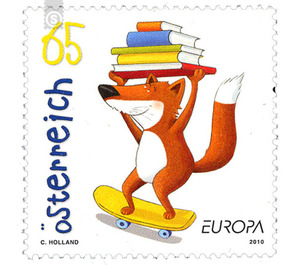CEPT - Austria / II. Republic of Austria 2010 - 65 Euro Cent
Theme: Animals
| Country | Austria / II. Republic of Austria |
| Issue Date | 2010 |
| Face Value | 65.00 |
| Edition Issued | 250,000 |
| Printing Type | offset |
| Stamp Type | Commemorative |
| Item Type | Stamp |
| Chronological Issue Number | 2209 |
| Chronological Chapter | OOS-OE2 |
| SID | 513593 |
| In 64 Wishlists | |
The theme of this year's EUROPA brands, set by "Posteurop", the Association of European Postal Societies, is "Children's Books". The draft of the corresponding special stamp from Austria comes from Carola Holland; The motif represents the "new" post-Fox Fridolin, whose exciting adventures have been published in several children's books in recent years. Riding on a skateboard and balancing five books over his head, the funny fox shows that charming cheerfulness that is often inherent in this theme. On the history of children's literature: In Europe served the first readings with which children were usually only in monastic schools in touch, primarily the religious instruction and only indirectly also the literacy. Even the invention of printing in the 15th century made it easier for children and adolescents to access literature for the time being only to a very limited extent. It was not until the 16th and the following centuries that texts began to be written especially for children - and especially those early fairy tale collections and works, for example by the Brothers Grimm, which partly reached into our own Enjoy time great popularity. In the so-called "moralistic children's literature" (17th and 18th century), however, it should be noted that child mortality was once very high; and since only about every second person reached adulthood, the educational sense lay above all in the preparation of the children for their own death. Some of the first children's books that also had entertainment value in addition to a purely educational message were published by an English publisher named John Newbery in the 1740s. One of the most successful children's books of the 19th century is undoubtedly Heinrich Hoffmann's "Struwwelpeter"; even if, or just because the educational message is clearly recognizable in it, the grotesquely exaggerated illustrations and texts have their own comic, which was, however, partially not noticed. Historians, however, agree that Lewis Carroll's stories of "Alice in Wonderland" (1865) are the first to contain any moralistic message. By the way, in the same year Wilhelm Busch's famous rhyme stories of "Max and Moritz" appeared. In today's children's literature, almost everything is presented in an age-appropriate way; the variety of topics is accordingly large and has the same range as in adult literature. Of the many Austrian writers of this genre, special mention should be made of Mira Lobe, Christine Nöstlinger and Thomas Brezina.


